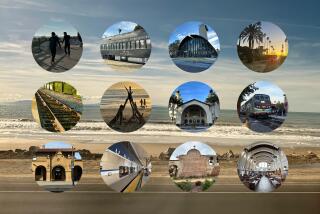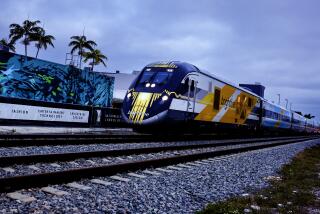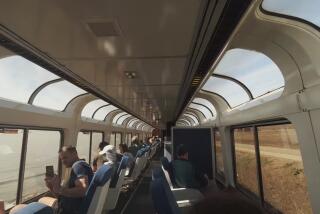A high-speed zip across Europe by train
- Share via
Last winter, when Kelly, my teenage son, and I rode trains for a total of 50 hours across France, Germany, Britain and the Low Countries on a frenetic two-week trip (journalistic research for me), we never waited long or walked far to make a connection. People are on the move, making fast, seamless connections between high-speed and regional trains, subways, trams, ferries and buses.
It was, I discovered, all about connectivity and frequency.
That connectivity began at Amsterdam’s Schiphol Airport, where we caught a Dutch Railways regional train beneath the passenger terminal and were deposited 10 minutes later at the Central Station. That day, we took a canal tour, visited the Anne Frank House and walked the streets, which smelled of marijuana and hashish smoke wafting from coffee shops. As we boarded a Thalys train for Brussels the next morning, young people smoked pot-laced cigarettes as they tried to finish their stash before leaving the country.
Thalys, operated by a consortium and part of the French TGV (Train à Grande Vitesse) family of high-speed trains, began running the Amsterdam-Brussels-Paris route in 1996. Like high-speed trains everywhere — including Amtrak’s Acela in the Northeast Corridor —Thalys runs on welded rail and draws power from an overhead electrical catenary. The train was so smooth and quiet that it was difficult to judge our speed until we paralleled a highway and, going 140 mph, we blew by traffic.
At Brussels’ Midi/Zuid station, we switched to the Eurostar for London. I paid $206 each for first-class seats for what I hoped would be a singular rail experience. The Eurostar might have had problems last winter with stalled trains deep inside the Chunnel, but on this night, it did not disappoint. The staff, in snappy gray outfits, immediately brought wine and bottled water and then served a full dinner on china plates. We read foreign newspapers, sipped cappuccinos and felt as if we had returned to the golden age of passenger railroading.
But even those streamliner trains were never this swift. The train can reach 186 mph. A blast of air rocked our car when we entered the Eurotunnel, which runs 26 miles beneath the English Channel. A bit of pressure in the ears was relieved by a big yawn.
It was like flying.
Two days later, at 10 p.m., we boarded a Caledonian Sleeper, pulled by ScotRail, from London’s Euston Station. Owing to shorter distances and faster speeds in Europe, overnight trains are rather rare. I’d book us all the way to Fort William in the northwest of Scotland, an 11-hour trip, to ensure a full night’s sleep.
We passed the first hours in a parlor car filled with couches and tables. Somewhere near York, we retired to the bedroom and passed a comfortable night beneath down comforters. In Edinburgh, while it was still dark, our car switched from an electric to a diesel locomotive, and we continued across the waist of Scotland and north into the Highlands.
From Edinburgh, the train is known as the Deerstalker — an apt moniker. As we ate a breakfast of bacon sandwiches and shortbread, big-bodied roe deer, including stags with huge antlers, bounded away from the train.
Fort William is a lovely town with a cobblestone shopping district packed with jewelry, woolens and hiking stores that cater to trekkers exploring nearby Ben Nevis, the highest mountain in Great Britain. We stashed our bags in a locker and shopped before boarding a couple of utilitarian self-powered diesel coaches for a day trip to Mallaig, a fishing village and ferry port on the western coast
In summer, a steam locomotive, the Jacobite, chugs up this part of the West Highland Railway, one of the last major lines built in Britain. It’s one of the most scenic rail trips in Europe, featuring mirror-like lochs and muscular rock formations. A highlight for Kelly was traveling over the Glenfinnan Viaduct, a 21-arch railroad bridge that has appeared in several “ Harry Potter” movies. It crosses Loch Shiel, the location of the fictional Hogwarts Lake. In Mallaig, the engineer parked the coaches at the station and locked the doors. We had four hours to walk down to the sea, climb to an overlook and then warm up in a pub with a meal of fresh haddock. This far north, the sun sets just before 4 p.m., and there was no sightseeing on the way back to Fort William and the four-hour trip onto Glasgow.
We rested a day before boarding a Virgin train to London. The trip started off well enough. We had two first-class facing seats, a table with a reading lamp, and access to wireless Internet. We e-mailed pictures of the trip home; Kelly updated his Facebook page. The train purred along at 110 mph. By the Midlands, however, there were problems ahead with the electrical infrastructure. Trains were being canceled, and in Birmingham, stranded passengers crowded aboard our train until they stood in the aisles and sat on luggage between cars. Brits complain about their rail system when they compare it to the bullet trains racing across the Continent, but their intercity trains generally are reliable and frequent.
Back at Euston Station, we bought Cornish pasties for dinner and switched to a regional train to Portsmouth, where we boarded an overnight ferry to France. We arrived at 5 a.m. A bus waited outside the terminal to take us inland to the train station in Caen. On that deserted highway, a good student of D-Day (and I’m one) would recognize the landmarks and towns. I pointed out the turnoff for the Pegasus Bridge and began an explanation when I noticed Kelly was asleep. He woke long enough to stumble aboard a French Railways train that ran nonstop to Paris, 234 miles away.
The sun rose in a hazy mist. Normandy emerged in monochromatic hues — yellow-brown stucco homes with terracotta roofs, silhouetted church steeples and fields framed with hedgerows. By American standards, the train was fast — probably 110 mph plus — but it was no TGV. When I walked to the end of the coach to close the restroom door, I heard a roar of air and realized the toilet flushed onto the tracks. I haven’t seen a “hole in the floor” since the 1970s, when Amtrak was still running cars built in the 1930s.
Two days later, we left Paris from the Gare du Nord on a TGV service to Stuttgart, Germany. I plugged ear buds into a radio receiver between the seats and found a station playing Mozart. The countryside flew by at a dizzying pace. Reaching speeds of 160 mph, the train covered 400 miles (with stops) in just 3.3 hours.
At Stuttgart, we switched to an Intercity Express ( ICE) built by Siemens and operated by Deutsche Bahn, the German national railway. I fell in love with these high-speed trains and their wide, bright coaches with separate family compartments. The dining cars served full meals of sauerkraut and sausages and other regional fare.
We stopped in Munich for a couple of days and walked the Marienplatz, the heart of the historic district. One morning we took the Third Reich Walking Tour and met the English-speaking guide beneath the Rathaus-Glockenspiel.
She took us to the Hofbräuhaus, where Hitler gave one of his first beer hall speeches. It was an odd tour. As we walked the streets, she would pull from her purse old photos of bombed-out buildings and copies of drawings by Adolf Hitler, the art student. Whenever elderly people passed by, she lowered her voice, “I don’t want to upset them.”
We had only a day in Berlin, but I wanted to see the Reichstag and the Brandenburg Gate, and I welcomed the six-hour ICE ride. Somewhere north of Nuremberg, the architecture and décor changed. Gutted factories, drab apartment buildings and graffiti-covered walls characterized some cityscapes along the tracks — clear signs we had entered the former East Germany.
Division is still evident too in Berlin. Despite all the construction since the Wall fell in 1989, there’s still much vacant land around the city center. A symbol of the city’s renaissance and reunification, however, is the Berlin Hauptbahnhof, the central train station completed in 2006. This soaring structure of glass and steel, with a 900-foot-long train shed and three levels of track, handles 1,100 trains a day.
We caught our final ICE train here, one of six nonstops that day to Amsterdam. Hours later, we were in the lounge chatting with a German college student and his Australian girlfriend when the train — just 40 miles outside Amsterdam — suddenly slowed and jerked into a station. An announcement was made in German.
The student interpreted, “They say something is wrong with this train. We have to get off.” About 200 or 300 of us got off with our luggage onto a concrete platform. This wasn’t unfamiliar. I’d been on Amtrak trains that had died in cornfields or been stuck on sidings for hours. Usually, Amtrak sends motor coaches to gather up passengers, because there’s no redundancy in the system.
Not here. Ten minutes later, a Dutch Railways regional train pulled to the stop, threw open its doors and we all piled on. Now that’s connectivity and frequency.
More to Read
Sign up for The Wild
We’ll help you find the best places to hike, bike and run, as well as the perfect silent spots for meditation and yoga.
You may occasionally receive promotional content from the Los Angeles Times.






